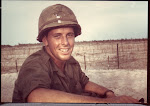DA NANG: For five months and 18 days in the in the
first half of 1968 the world watched as US forces held and defended the US
Marine Base at Khe Sanh in northwestern South Viet Nam. US Commanding General William Westmoreland’s
strategy at the time was to draw enemy forces into that area and destroy
them. The plan from the Vietnamese side
was to distract the American military at Khe Sanh so they could pull off the
Tet Offensive of 1968, the largest battle of the Viet Nam War. While large numbers of US forces were
occupied at Khe Sanh the Vietnamese were able to more easily attack every major
city in the South from Quang Tri to Can Tho in the Mekong Delta, including the
major southern city Saigon.
Plattsburgh US
Army veterans Neil Tallon, Corky Reinhart and Pete Conroy, accompanied by the
well known writer and humanitarian Le Ly Hayslip , have traveled since morning
from Hue to Quang Tri and from there on the major Vietnamese route into the
mountains towards Laos. The site of the
old US Marine base at Khe Sanh is along this route, eight miles from the
Laotian border.
 |
| Neil Tallon, Pete Conroy, Corky Reinhart, David Hansen in Khe Sanh. |
Corky Reinhart,
retired professor and army veteran of Germany during the Vietnam era has not
been in this part of Viet Nam before. “I’ve
never seen such beautiful country” says Corky, “but I’d not want to be marching
up and over these mountains with a rifle and a full pack. No way”.
 |
| Neil Tallon and Pete Conroy being interviewed by a VN Television news team. |
 |
| Pete Conroy, Le Ly Hayslip, Neil Tallon and Mark Conroy. |
”Well Corky,”
replies Pete, “I was going up and down mountains like these between Khe San and
the Au Shau , hacking my way through jungle all the way and getting shot at to
boot. It wasn’t any fun”.
A small but
thorough military museum sits near the location of the old airstrip on the Khe
Son site. Not much remains from that
earlier time other than a row a revetments where helicopters and other aircraft
were parked. A well preserved US Army Huey and Chinook helicopter are parked
where the ramp once was along with a US Air Force C-130. An adequate system of trenches, tunnels and
bunkers have been reconstructed to show how the site looked in 1968.
The small
museum building nearby houses a collection of military artifacts and photos
from the siege. Captions on the photos
do not favor the US forces but do appear fairly accurate technically. A television crew filming on site requests an
interview with Pete Conroy the only veteran available who fought in this area
during the siege in 1968. They conducted
a long interview for broadcast on their network.
American forces
closed down and withdrew from Khe Sanh in early July 1968. During the siege US aircraft dropped over
100,000 tons of bombs in the surrounding area, five tons for each of the twenty
thousand NVA soldiers who fought there.
 |
| Pete Conroy looking over the Press Republican while waiting for that last chopper out of Khe Sanh. |
On July 9 the
National Liberation Front flag flew over the Khe Sanh airfield.
Not forever
however, for a less known function of the Khe Sanh base and airstrip was it
being the support base for Operation Lam Son 719, the invasion of Laos, in
February and March 1971. Because the US Forces were forbidden by law from
entering Laos they provided air support, artillery and logistics and the ARVN (Army
Republic Viet Nam) provided the ground troops.
David Hansen, a
US veteran of the Lan Som 719 Operation was at the Khe Sanh site having a
coffee. “I was a dust off (medical
evacuation) pilot during that operation” he said. “There was a medical unit set up here at Khe
Sanh and we flew from here and back where ever calls for help were received
from. We were flying all the time so
many choppers went down”.
In that
operation the US had 168 destroyed and 618 damaged helicopters. The re-organized Khe Sanh was abandoned once
again on April 6, 1971.
David Hansen
made a recent trip to Khe Sanh with some veterans of the Iraq and Afghanistan
wars. “they were interested in coming
here”, he said “to see how we dealt with our ‘after the fighting’ and how it
might help them understanding their plight”.
*A version of this article appeared in the Press Republican on April 1, 2014.

No comments:
Post a Comment